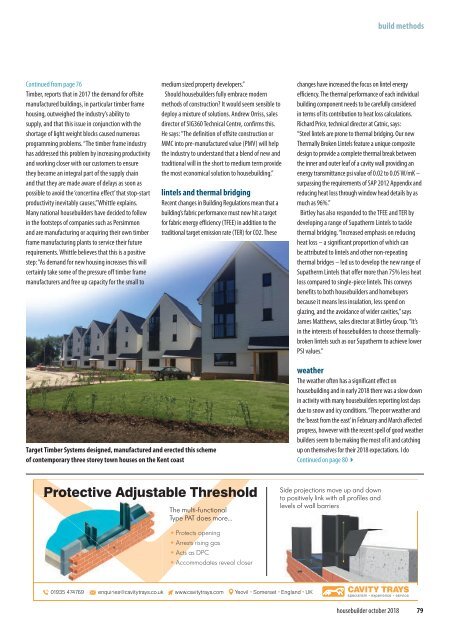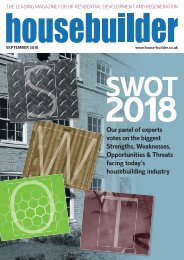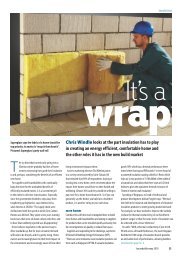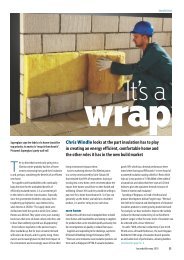Housebuilder October 2018
Create successful ePaper yourself
Turn your PDF publications into a flip-book with our unique Google optimized e-Paper software.
uild methods<br />
Continued from page 76<br />
Timber, reports that in 2017 the demand for offsite<br />
manufactured buildings, in particular timber frame<br />
housing, outweighed the industry’s ability to<br />
supply, and that this issue in conjunction with the<br />
shortage of light weight blocks caused numerous<br />
programming problems. “The timber frame industry<br />
has addressed this problem by increasing productivity<br />
and working closer with our customers to ensure<br />
they become an integral part of the supply chain<br />
and that they are made aware of delays as soon as<br />
possible to avoid the ‘concertina effect’ that stop-start<br />
productivity inevitably causes,” Whittle explains.<br />
Many national housebuilders have decided to follow<br />
in the footsteps of companies such as Persimmon<br />
and are manufacturing or acquiring their own timber<br />
frame manufacturing plants to service their future<br />
requirements. Whittle believes that this is a positive<br />
step: “As demand for new housing increases this will<br />
certainly take some of the pressure off timber frame<br />
manufacturers and free up capacity for the small to<br />
medium sized property developers.”<br />
Should housebuilders fully embrace modern<br />
methods of construction? It would seem sensible to<br />
deploy a mixture of solutions. Andrew Orriss, sales<br />
director of SIG360 Technical Centre, confirms this.<br />
He says: “The definition of offsite construction or<br />
MMC into pre-manufactured value (PMV) will help<br />
the industry to understand that a blend of new and<br />
traditional will in the short to medium term provide<br />
the most economical solution to housebuilding.”<br />
lintels and thermal bridging<br />
Recent changes in Building Regulations mean that a<br />
building’s fabric performance must now hit a target<br />
for fabric energy efficiency (TFEE) in addition to the<br />
traditional target emission rate (TER) for CO2. These<br />
changes have increased the focus on lintel energy<br />
efficiency. The thermal performance of each individual<br />
building component needs to be carefully considered<br />
in terms of its contribution to heat loss calculations.<br />
Richard Price, technical director at Catnic, says:<br />
“Steel lintels are prone to thermal bridging. Our new<br />
Thermally Broken Lintels feature a unique composite<br />
design to provide a complete thermal break between<br />
the inner and outer leaf of a cavity wall providing an<br />
energy transmittance psi value of 0.02 to 0.05 W/mK –<br />
surpassing the requirements of SAP 2012 Appendix and<br />
reducing heat loss through window head details by as<br />
much as 96%.”<br />
Birtley has also responded to the TFEE and TER by<br />
developing a range of Supatherm Lintels to tackle<br />
thermal bridging. “Increased emphasis on reducing<br />
heat loss – a significant proportion of which can<br />
be attributed to lintels and other non-repeating<br />
thermal bridges – led us to develop the new range of<br />
Supatherm Lintels that offer more than 75% less heat<br />
loss compared to single-piece lintels. This conveys<br />
benefits to both housebuilders and homebuyers<br />
because it means less insulation, less spend on<br />
glazing, and the avoidance of wider cavities,” says<br />
James Matthews, sales director at Birtley Group. “It’s<br />
in the interests of housebuilders to choose thermallybroken<br />
lintels such as our Supatherm to achieve lower<br />
PSI values.”<br />
Target Timber Systems designed, manufactured and erected this scheme<br />
of contemporary three storey town houses on the Kent coast<br />
weather<br />
The weather often has a significant effect on<br />
housebuilding and in early <strong>2018</strong> there was a slow down<br />
in activity with many housebuilders reporting lost days<br />
due to snow and icy conditions. “The poor weather and<br />
the ‘beast from the east’ in February and March affected<br />
progress, however with the recent spell of good weather<br />
builders seem to be making the most of it and catching<br />
up on themselves for their <strong>2018</strong> expectations. I do<br />
Continued on page 804<br />
housebuilder october <strong>2018</strong> 79







